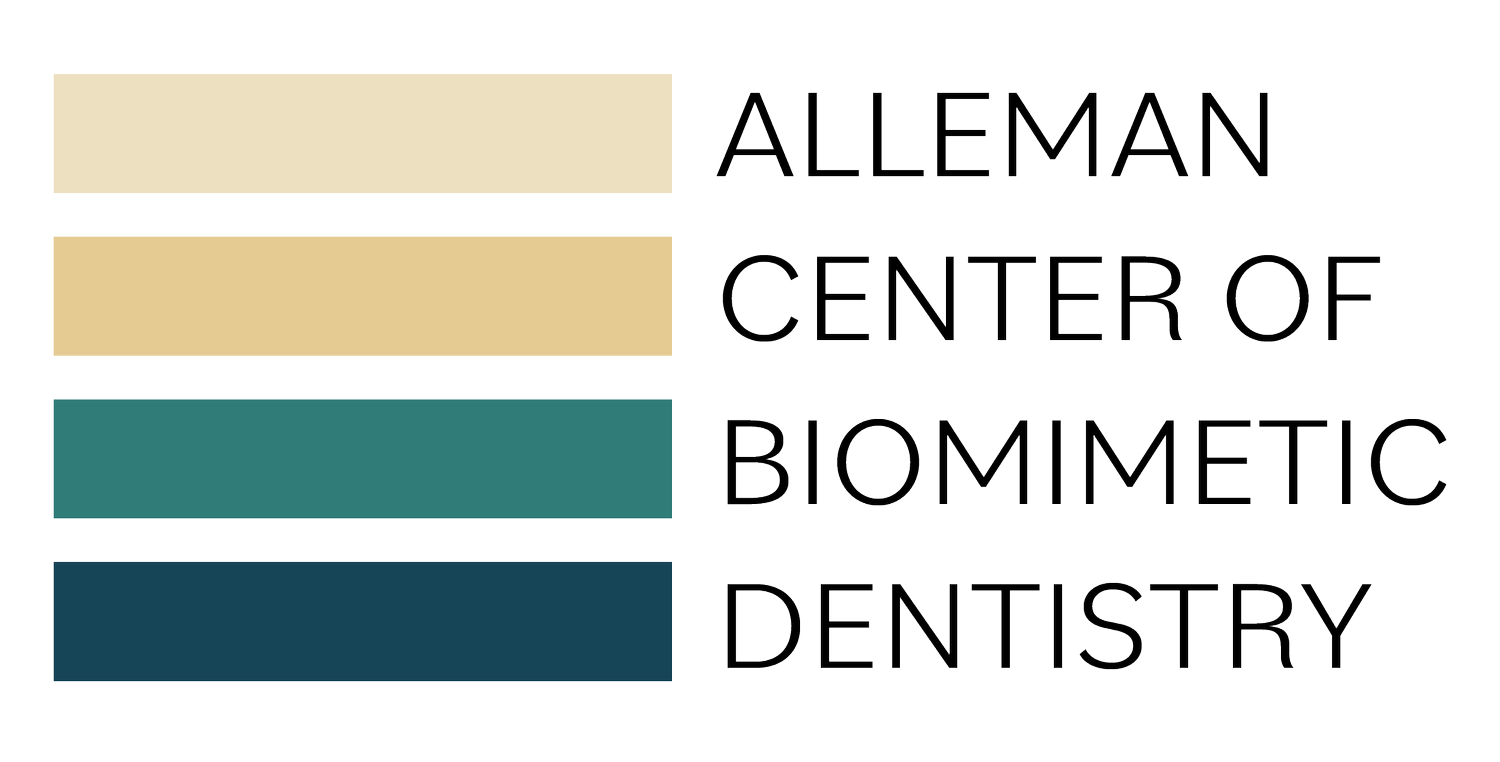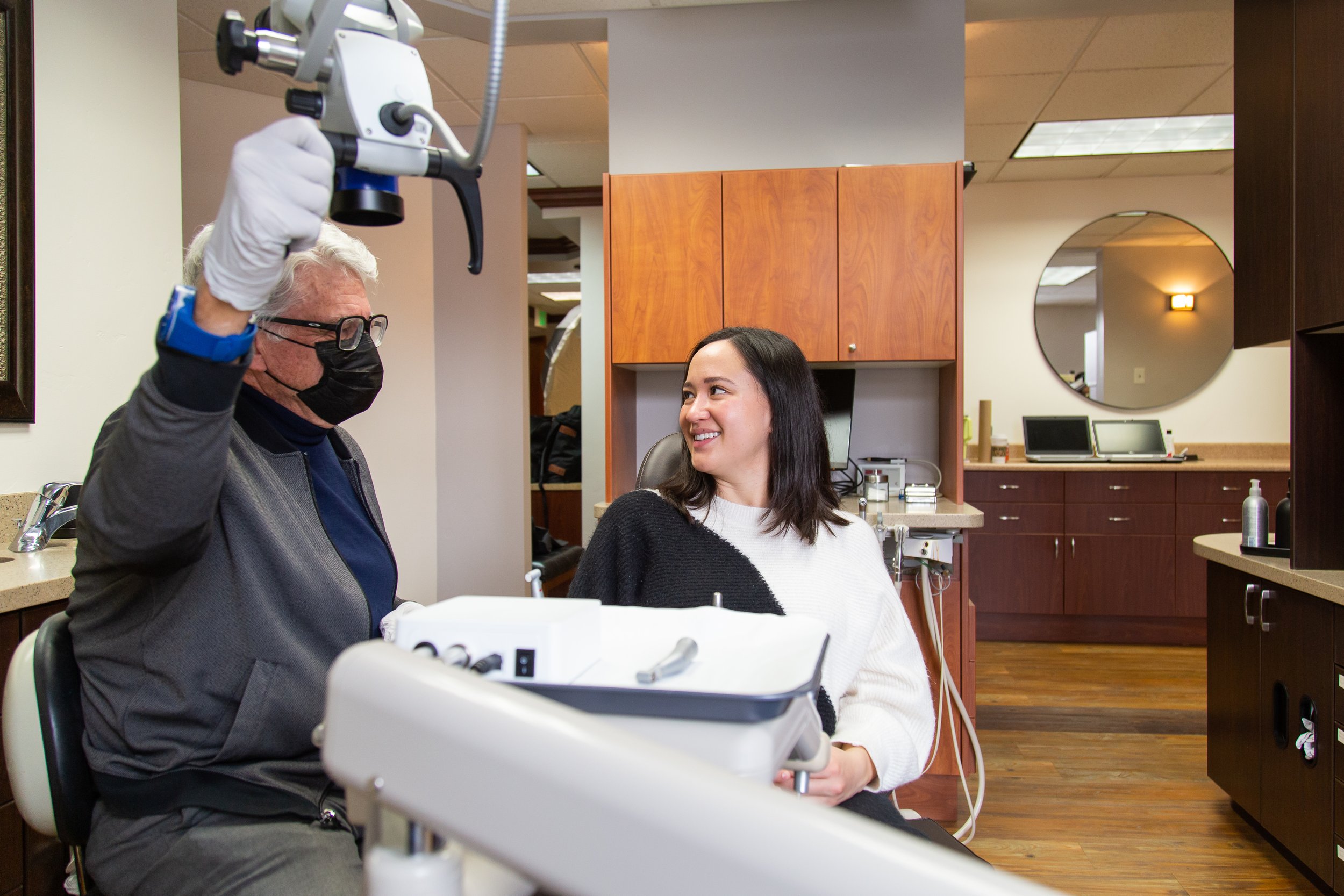Dr. David Alleman a Pioneer in Biomimetic Restorative Dentistry
Dr. David Alleman, DDS is one of the founding leaders in biomimetic restorative dentistry, but when he was first introduced to adhesive principles by Dr. Ray Bertolotti in 1995, he had already quit practicing dentistry. “For six months I wasn’t a dentist,” recalls Dr. Alleman. “For six months I studied history and looked into university programs so I could teach history as my new career.” So when Dr. Alleman attended a two-day course by Dr. Ray Bertolotti in adhesive dentistry, he was giving dentistry one more chance to show him that it could help his patients rather than just create more problems. “If I could just solve the issue of post-operative sensitivity, I could be happy as a dentist. That’s what I told myself when I registered for his course.”
Dr. David Alleman with a patient at the Alleman Center dental office in Provo, UT
This two-day course is what began Dr. Alleman’s seven years of investigating the principles that are now known as biomimetic restorative dentistry. Studying articles provided in the bibliography provided by Dr. Bertolotti, Dr. Alleman saw that, although improvements were being made in composite adhesive materials, they were still at the mercy of composite shrinkage. Lab research was being done on immediate dentin sealing by Pascal Magne, resin coating by Gary Unterbrink, the hybrid layer by Bart Van Meerbeek, the hydrodynamic theory of pain by Martin Brännström, c-factor by Carel Davidson, semi-direct techniques by Didier Dietschi and bonding to dentin by Takao Fusayama, but these independent discoveries did not resolve the issue of polymerization shrinkage.
What became clear to Dr. Alleman is that this issue of stresses caused by composite shrinkage was at the root of post-operative sensitivity and failing restorations.
“Without the research that has been done over the past 40 years, we wouldn’t have biomimetic dentistry today,” explains Dr. Alleman. “With this research and help from my mentors Ray Bertolotti, Gary Unterbrink and Bill Liebenberg, I identified 18 variables that affected a restoration’s longevity when bonding to dentin. As a golfer, I am told there are 72 variables that impact a golf swing, so 18 variables to consider for a better dental outcome seemed manageable to me.”
Dr. Alleman addressed these 18 variables with a set of protocols he called the Six Lessons Approach, an homage to golfer Ben Hogan and his book Ben Hogan’s Five Lessons: The Modern Fundamentals of Golf. As Dr. Alleman began using these protocols at his office, he saw the difference immediately. Root canal treatments dropped dramatically, sensitivity was eliminated and patients came back year after year with their restorations fully bonded and symptom-free.
But in order to find the published dental literature behind his Six Lessons Approach, Dr. Alleman had to travel to 35 dental school libraries around the United States. He recalls seeing dental students in the library, but they were only there to study for their course work. “Just like when I was a student, I saw that no one in the library was using the published articles. No one asked why a textbook included what it did or what it left out. Except now I was.” A literature review of this scale was not digitally accessible in 1998; instead, you were expected to make a photocopy of articles. This is what Dr. Alleman did at every library he visited — made copies of the hundreds of articles he studied. “When I reflect on what it took for me to access this research originally, I see how much has changed for dentists. Because we can share, discuss and learn from this research more easily today, more dentists are interested in what the published literature has to say.”
Teaching has evolved in a similar way. “When I first met a young dental researcher named Simone Deliperi from Italy who had come to the same conclusions as I did, that’s when I knew we were on the right path. When two people in two different parts of the world study the science and draw the same conclusions independent of one another, you know you’re onto something.” Dr. Alleman and Dr. Deliperi taught together for from 2008-2018, training one group of doctors at a time. But since then, new technology has made it possible to reach more doctors.
“In 2019, my daughter Hillary introduced me to Zoom, so we could train doctors anywhere in the world without them having to travel or take time off work. In January 2020, when I was ready to retire, we, myself and my son Dr. Davey Alleman, DMD, began teaching doctors online,” recalls Dr. Alleman.
Whether in person or online, teaching doctors hasn’t always been easy. Going against what has been taught in dental schools for decades can be met with skepticism before doctors understand the research behind the new techniques.
“What surprised me the most is who wanted training. I thought the doctors who were struggling would want this first, but I was wrong. It was the best doctors in their city, state or country who were the first to get trained because they were always looking for the best opportunities for their patients. And it’s still true to this day”
When Dr. Alleman is asked why he has devoted his life's work to improving the world of dentistry, it all comes back to the patients. Dr. Alleman began his literature review with the goal of finding better options for his patients, and he did. “Now when I see a patient, if they have a problem, I can fix it. I can truly resolve the cause of symptoms; unlike before, when traditional techniques were just having me cover them up or treat them in the wrong way. That is my favorite thing about being a dentist: helping people feel better.”
Dr. Alleman says the same thing about teaching and mentoring other doctors. Every day he enjoys helping doctors eliminate sensitivity and retreatment in their own work. “The doctors I have trained and the doctors those doctors have trained show that biomimetic dentistry is the future of dentistry.”
Even after a long career as a practicing dentist and pioneer in biomimetic dentistry, Dr. Alleman has no plans of slowing down. “I want to see biomimetic dentistry as the focus in conferences and dental schools around the world. Doctors need to know how much this can benefit their work and their patients.” And he is working hard to make this happen. In addition to teaching courses at the Alleman Center, Dr. Alleman will be presenting at conferences and teaching workshops in the United States, Turkey, Lithuania, the United Kingdom, Chile and Brazil in 2023, with more plans coming soon for 2024.
Despite his busy schedule, Dr. Alleman always enjoys connecting with new doctors. Email him at info@allemancenter.com, contact him on Instagram @david.alleman.dds or set up a one-on-one meeting with him. Learn more about his training programs, including in-person workshops and the Biomimetic Mastership. Dr. Alleman is always ready to discuss biomimetic restorative dentistry.
Dr. David Alleman was born in 1951. His father was a physicist who inspired his interest in science. Dr. Alleman graduated from Brigham Young University in 1975 with a bachelor’s degree in microbiology and minor in chemistry and University of the Pacific Dental School with a DDS in 1978. He currently lives in South Jordan, Utah and practices in Provo, Utah with his son Dr. Davey Alleman, DMD. When he isn’t practicing or teaching biomimetic dentistry, he enjoys golfing, studying history and spending time with his family.

